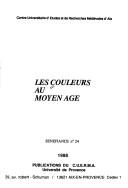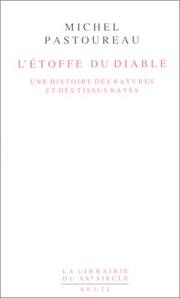| Listing 1 - 10 of 18 | << page >> |
Sort by
|
Book
ISBN: 1838806008 1838805990 Year: 2020 Publisher: London : IntechOpen,
Abstract | Keywords | Export | Availability | Bookmark
 Loading...
Loading...Choose an application
- Reference Manager
- EndNote
- RefWorks (Direct export to RefWorks)
Symbolism of colors. --- Color symbolism --- Symbolic colors --- Color --- Colors --- Psychological aspects
Book
ISBN: 3783107008 Year: 1983 Publisher: Stuttgart Kreuz
Abstract | Keywords | Export | Availability | Bookmark
 Loading...
Loading...Choose an application
- Reference Manager
- EndNote
- RefWorks (Direct export to RefWorks)
Color --- Symbolism of colors. --- Psychological aspects. --- Symbolism of colors --- Color symbolism --- Symbolic colors --- Psychological aspects --- Psychology --- Colors

ISBN: 290110424X 2821836856 9782901104247 Year: 1988 Volume: 24 Publisher: Aix-en-Provence Publ. du CUERMA
Abstract | Keywords | Export | Availability | Bookmark
 Loading...
Loading...Choose an application
- Reference Manager
- EndNote
- RefWorks (Direct export to RefWorks)
Comparative literature --- Thematology --- anno 500-1499 --- Color in art. --- Symbolism of colors. --- Arts, Medieval. --- Color in art --- Symbolism of colors --- Arts, Medieval --- Color symbolism --- Symbolic colors --- Color --- Colors --- Colors in art --- Art --- Monochrome art --- Psychological aspects --- Conferences - Meetings --- peinture --- teinture --- couleur
Book
ISBN: 2051008647 9782051008648 Year: 1987 Publisher: Genève Clairefontaine
Abstract | Keywords | Export | Availability | Bookmark
 Loading...
Loading...Choose an application
- Reference Manager
- EndNote
- RefWorks (Direct export to RefWorks)
History of Europe --- anno 500-1499 --- Symbolism in art --- Symbolism of colors --- Illumination of books and manuscripts, Medieval --- Themes, motives --- -Symbolism in art --- Color symbolism --- Symbolic colors --- Color --- Colors --- Allegory (Art) --- Signs and symbols in art --- Art --- Painting, Medieval --- Psychological aspects --- Symbolism in art. --- Symbolism of colors. --- Themes, motives. --- -Symbolism in art. --- Illumination of books and manuscripts, Medieval - Themes, motives

ISBN: 2020130874 9782020130875 Year: 1991 Publisher: Paris Éditions du Seuil
Abstract | Keywords | Export | Availability | Bookmark
 Loading...
Loading...Choose an application
- Reference Manager
- EndNote
- RefWorks (Direct export to RefWorks)
Clothing and dress --- Clothing and dress in art --- History --- Histoire culturelle --- Histoire médiévale --- sensibilité --- CDL --- 391 --- Textile design --- Symbolism of colors --- Color symbolism --- Symbolic colors --- Color --- Colors --- Decoration and ornament --- Design --- Textile industry --- Psychological aspects --- Clothing and dress - History --- Clothing and dress in art - History
Book
ISBN: 9780691139302 069113930X Year: 2009 Publisher: Princeton, N.J. Princeton University Press
Abstract | Keywords | Export | Availability | Bookmark
 Loading...
Loading...Choose an application
- Reference Manager
- EndNote
- RefWorks (Direct export to RefWorks)
Black, favorite color of priests and penitents, artists and ascetics, fashion designers and fascists, has always stood for powerfully opposed ideas: authority and humility, sin and holiness, rebellion and conformity, wealth and poverty, good and bad. In this book, the author of Blue now tells the fascinating social history of the color black in Europe. In the beginning was black, he tells us. The archetypal color of darkness and death, black was associated in the early Christian period with hell and the devil but also with monastic virtue. In the medieval era, black became the habit of courtiers and a hallmark of royal luxury. Black took on new meanings for early modern Europeans as they began to print words and images in black and white, and to absorb Isaac Newton's announcement that black was no color after all. During the romantic period, black was melancholy's friend, while in the twentieth century black (and white) came to dominate art, print, photography, and film, and was finally restored to the status of a true color. For the author, the history of any color must be a social history first because it is societies that give colors everything from their changing names to their changing meanings, and black is exemplary in this regard. In dyes, fabrics, and clothing, and in painting and other art works, black has always been a forceful and ambivalent shaper of social, symbolic, and ideological meaning in European societies.
Black --- Color --- Symbolism of colors --- Black in art --- Psychological aspects&delete& --- History --- Social aspects&delete& --- Color symbolism --- Symbolic colors --- Colors --- Chromatics --- Colour --- Chemistry --- Light --- Optics --- Thermochromism --- Dyes and dyeing --- Psychological aspects --- psychological primary colors --- Semiotics --- Iconography --- History of civilization --- black [color] --- Black in art. --- Black. --- History. --- Social aspects --- kleurgebruik
Book
ISBN: 9780691159362 069115936X Year: 2014 Publisher: Princeton, N.J. Princeton University Press
Abstract | Keywords | Export | Availability | Bookmark
 Loading...
Loading...Choose an application
- Reference Manager
- EndNote
- RefWorks (Direct export to RefWorks)
"In this beautiful and richly illustrated book, the acclaimed author of Blue and Black presents a fascinating and revealing history of the color green in European societies from prehistoric times to today. Examining the evolving place of green in art, clothes, literature, religion, science, and everyday life, Michel Pastoureau traces how culture has profoundly changed the perception and meaning of the color over millennia--and how we misread cultural, social, and art history when we assume that colors have always signified what they do today. Filled with entertaining and enlightening anecdotes, Green shows that the color has been ambivalent: a symbol of life, luck, and hope, but also disorder, greed, poison, and the devil. Chemically unstable, green pigments were long difficult to produce and even harder to fix. Not surprisingly, the color has been associated with all that is changeable and fleeting: childhood, love, and money. Only in the Romantic period did green definitively become the color of nature. Pastoureau also explains why the color was connected with the Roman emperor Nero, how it became the color of Islam, why Goethe believed it was the color of the middle class, why some nineteenth-century scholars speculated that the ancient Greeks couldn't see green, and how the color was denigrated by Kandinsky and the Bauhaus. More broadly, Green demonstrates that the history of the color is, to a large degree, one of dramatic reversal: long absent, ignored, or rejected, green today has become a ubiquitous and soothing presence as the symbol of environmental causes and the mission to save the planet. With its striking design and compelling text, Green will delight anyone who is interested in history, culture, art, fashion, or media."
Green --- Color --- Symbolism of colors --- 536.5 --- cultuurgeschiedenis --- groen --- Color symbolism --- Symbolic colors --- Colors --- Chromatics --- Colour --- Chemistry --- Light --- Optics --- Thermochromism --- Psychological aspects&delete& --- History --- Social aspects&delete& --- Hisstory --- natuurkunde, licht, kleurenleer - kleurenpsychologie --- Psychological aspects --- Semiotics --- Physiology of nerves and sense organs --- Aesthetics of art --- History of civilization --- symbolic color --- green [color] --- Social aspects --- kleurenpsychologie
Book
ISBN: 9780691198255 069119825X Year: 2019 Publisher: Princeton, N.J. Princeton University Press
Abstract | Keywords | Export | Availability | Bookmark
 Loading...
Loading...Choose an application
- Reference Manager
- EndNote
- RefWorks (Direct export to RefWorks)
Illuminated with a wide variety of images, this book traces the long history of yellow around the world. In antiquity, yellow was considered a sacred color, a symbol of light, warmth, wealth, and prosperity. But in medieval Europe, it became highly ambivalent: greenish yellow came to signify demonic sulfur and bile, the color of forgers, felon knights, traitors, Judas, and Lucifer-while warm yellow recalled honey and gold, serving as a sign of joy, pleasure and abundance. The yellow stars of the Holocaust were seared into the color's negative tradition. In Europe today, yellow has diminished to a discreet color. Greenish yellow can still be seen as dangerous, sickly, or poisonous, and golden yellow remains positive, but the color is absent in much of everyday life and is lacking in symbolism. In Asia, however, yellow pigments like ocher and orpiment and dyes like saffron, curcuma, and gaude are abundant. Painting and dyeing in this color has been easier than in Europe, offering a richer and more varied palette of yellows that has granted the color a more positive meaning. In ancient China, for example, yellow clothing was reserved for the emperor. In India, the color is seen as a source of happiness: wearing a little yellow is believed to keep evil away. And importantly, it is the color of Buddhism, whose temple doors are marked with the color. Yellow continues to have different meanings in different cultural traditions, but in most, the color remains associated with light and sun, something that can be seen from afar and that seems warm and always in motion.
Affective and dynamic functions --- Iconography --- History of civilization --- yellow [color] --- psychological primary colors --- Yellow --- Color --- Symbolism of colors --- Yellow in art --- Psychological aspects&delete& --- History --- Social aspects&delete& --- Color symbolism --- Symbolic colors --- Colors --- Psychological aspects --- Chromatics --- Colour --- Chemistry --- Light --- Optics --- Thermochromism --- Social aspects --- kleurgebruik
Book
ISBN: 9783050060682 3050060689 1306488559 9781306488556 9783050050812 Year: 2012 Publisher: Berlin [Germany]
Abstract | Keywords | Export | Availability | Bookmark
 Loading...
Loading...Choose an application
- Reference Manager
- EndNote
- RefWorks (Direct export to RefWorks)
Für die Kulturgeschichte des westlichen Abendlandes seit der Antike sind Imaginationen von Farben in Literatur und Kunst konstitutiv. Besonders das christliche Mittelalter bedient sich der Farben, vielfach in Form einer bildkünstlerischen oder sprachlich erzeugten Zusammensetzung monochromer Flächen, um etwa die Substantiierung des Göttlichen in den "colores" zur Anschauung zu bringen oder Aspekte des sozialen Status von Personen, höfischer Pracht oder sozialer Unordnung darzulegen. Zu zeigen gilt es, dass Farben mithin im Rahmen kultureller Selbstvergewisserungsdebatten auch in Literatur und Kunst als sinngenerierende Medien und keineswegs als bloßes Dekorum fungieren. Die in diesem Band versammelten Beiträge gehen davon aus, dass die vielfältigen Verfahren der Farbevokation, wie sie in Literatur und Kunst vom Mittelalter bis zur Gegenwart begegnen, Teil jener historisch allererst präzise zu ermittelnden Selbstbeschreibungsverfahren sind, die Konzepte von gesellschaftlicher und personaler Identität erzeugen. An exemplarischen Erzähltexten aus Mittelalter und Neuzeit sowie an Beispielen aus der Kunstgeschichte erarbeiten die Autoren einerseits poetologisch-ästhetische Implikationen von Farballusionen und andererseits deren diskurshistorische Zusammenhänge. Der Band umfasst in seinem Kern Arbeiten zu den Farbsemantiken in der höfischen Erzählliteratur. Ausgehend von diesem Zentrum werden die Farbdiskurse der neueren Literatur exemplarisch erörtert. Dies geschieht z. B. an Goethes Farbenlehre, dem Antikediskurs der deutschen Klassik oder an rassistischen Farbstereotypen im 19. und 20. Jahrhundert. Darüber hinaus werden die Funktionen von Blutseiten in spätmittelalterlichen Handschriften erörtert, die Rezeption von Pontormo in Video-Klang-Installationen der Gegenwartskunst sowie die Farben der Karthographie.
Color in art --- Color in literature --- Symbolism of colors --- German literature --- Art, German --- German art --- Fels (Group of artists) --- Gruppe 1950 (Group of artists) --- HobbypopMUSEUM (Group of artists) --- Kooperative Kunst (Group of artists) --- Kugel (Group of artists) --- Lücke (Group of artists) --- Color symbolism --- Symbolic colors --- Color --- Colors --- Colors in art --- Art --- Monochrome art --- Themes, motives --- Psychological aspects

ISBN: 9187484080 9789187484087 Year: 1994 Volume: 41 Publisher: Göteborg Etnografiska Museet
Abstract | Keywords | Export | Availability | Bookmark
 Loading...
Loading...Choose an application
- Reference Manager
- EndNote
- RefWorks (Direct export to RefWorks)
Buddhism --- Indian religions --- Asia --- Buddhist art and symbolism. --- Colors --- Symbolism of colors. --- Mahayana Buddhism --- Religious aspects --- Mahayana Buddhism. --- Rituals. --- Buddhist art and symbolism --- -Mahayana Buddhism --- -Symbolism of colors --- Color symbolism --- Symbolic colors --- Color --- Greater vehicle --- Northern Buddhism --- Northern vehicle --- Buddhist sects --- Colours --- Buddhist symbolism --- Lamaist symbolism --- Symbolism and Buddhist art --- Symbolism --- Rituals --- Psychological aspects --- Symbolism of colors --- Religious aspects&delete& --- Colors - Religious aspects - Mahayana Buddhism. --- Mahayana Buddhism - Rituals.
| Listing 1 - 10 of 18 | << page >> |
Sort by
|

 Search
Search Feedback
Feedback About UniCat
About UniCat  Help
Help News
News